“…today we’re talking about this little fish of mine. But more on that later.”
When twilight comes, it’s time to light your lantern. But sometimes human technology isn’t enough to get past nature’s barriers. That was the case when early sonar came up against the lanternfish, which congregates in the millions. This tiny mesopelagic creature bioluminates the twilight zone, following the gray haze up and down with the turning of the earth. But following the light is one way to find food in Life, Death, and Taxonomy.
Description
- The spotted lanternfish is basically a giant-eyed sardine
- It has a thin body, mottled brown scales, and yes, massive eyes characteristic of animals that live at the bottom of the ocean
- It also has a slightly protruding snout that I guess is snake-looking but it really just looks like a standard minnow face.
Measure Up
Welcome to the beloved Measure Up segment. The official listener’s favorite part of the show! The part of the show when we present the animal’s size and dimension in relatable terms through a quiz that’s fun for the whole family. It’s also the part of the show that’s introduced by you when you send in audio of yourself saying, singing, or chittering the words Measure Up into ldtaxonomy at gmail dot com. We don’t have a measure up intro, so we’ll look back in the archives for our greatest hits.
Length
- 11 cm (4.3 in)
- How many lanternfish go into the height of the largest sky lantern ever made?
- Hint: The largest lantern was created in January 2009 in Columbia. The lantern was given the title “Homenaje a la Fauna del Planeta” or “Planets Wildlife Tribute.”
- 106.7 lanternfish. The lantern was 11.68 m (38 ft 3 in).
Dive depth
- They may be found as low as 1000 m (3,280 feet).
- How many lanternfish depths would it take to get to space?
- Hint: The U.S. decided that space would officially start where the atmospheric pressure dropped to less than one pound per square foot.
- 80 lantern fish depths. Space starts at 50 miles (81 km) up.
Fast Facts
- Range: North Atlantic and the Mediterranean – only at depths of 1000m
- Diet: eats copepods and euphausiids (just gonna leave that there since we definitely all know exactly what those things are and encounter them every day) – Basically zooplankton and krill.
Major Fact: The Sea Wall
In the early 1900s, humans started to learn to use echoes to judge distance and locations. Today, SONAR is what we call the use of sound to bounce off of things underwater. In those early years, scientists used hypersonics in the ocean and found something deep below the surface that reflected SONAR.
It was thought that they had found the ocean floor. Surely only that could explain this barrier that seemed to be so vast. The only problem… the floor would move. Depending on the time of day, this SONAR reflective surface would move up or down.
They called it the deep scattering layer.
What was thought of as a floor is actually a great mass of animals. Fish collect in what is called the twilight zone. An area of the ocean that light just barely reaches. Many of these fish are lanternfish, because when the light fades, you’ll need a lantern.
At night, the fish follow the twilight toward the surface to feed.
It’s not strange to find that animals can reflect SONAR. If you’ve ever used a fish finder, you know that you can find schools of fish that way. But this wall of fish seemed to stretch unbroken for hundreds of miles. Today we know the deep scattering layer stretched all over the world’s oceans. In fact, the biomass of fish in the deep scattering layer could be greater than 30 times the current human population.
Lanternfish are so numerous that they make up 65% of all life in the deep sea. These fish move together and evade predators using their lateral line systems, which are special organs that help them detect small pressure changes in the water.
Lanternfish have well-developed swim bladders that allow them to ascend hundreds of feet each night. But this swim bladder filled with gas seems to reflect SONAR particularly well.
Lanternfish are also instrumental in keeping the planet cool.
So we are familiar with the concept of global warming through a buildup of carbon dioxide. The ocean is a big part of the carbon cycle. Phytoplankton absorb CO2 and convert it into organic carbon, which is eaten by zooplankton, which is a major food supply for the oceans predators.
Then dead cells, detritus, and fecal matter drift downward in what is called marine snow. Marine snow forms the basis of the deep sea food chain.
However, lanternfish that make this up and down journey each day directly transport carbon from the surface to the deep sea, aiding the ocean’s absorption of carbon.
Ending: So kick on those KC lights, keep those giant, unblinking eyes open (as though you had a choice) and scramble those u-boat sonars like the lanternfish here in LDT.

